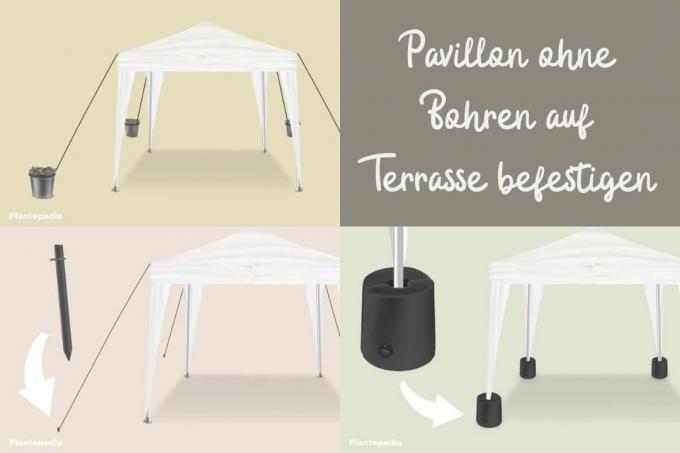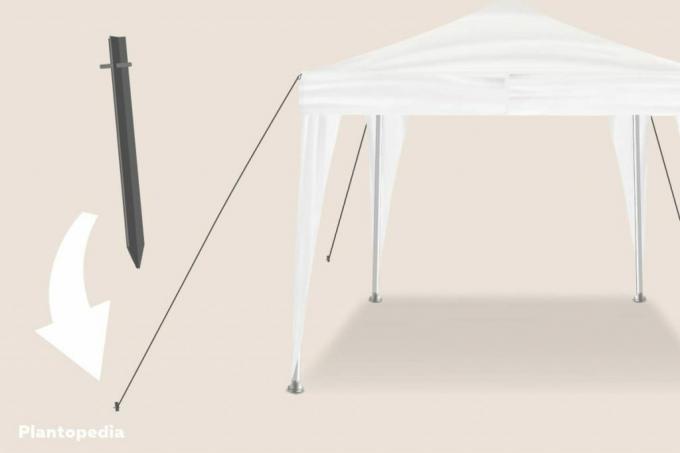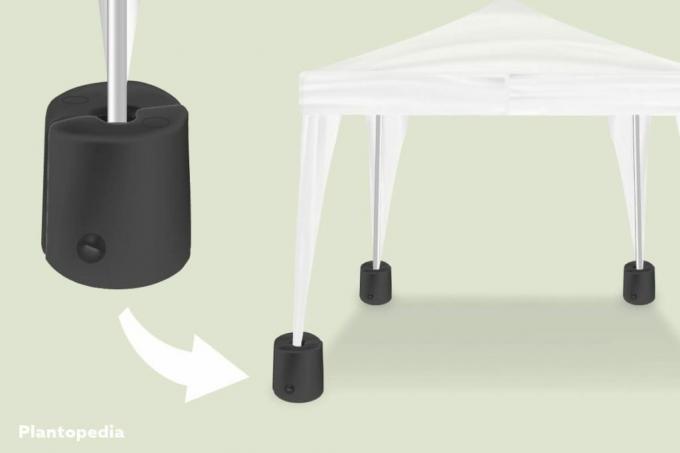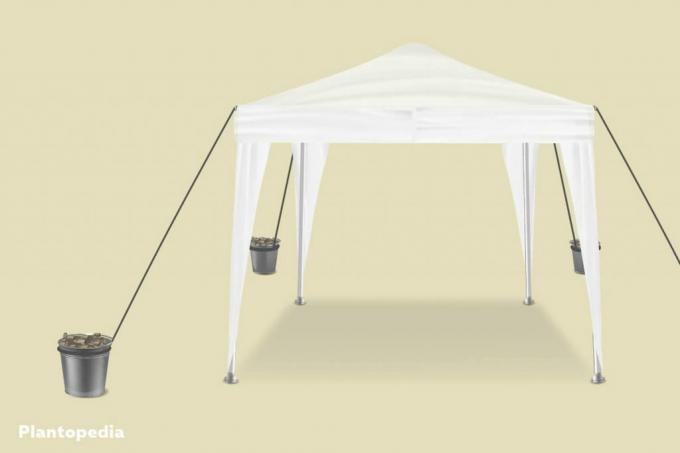
table of contents
- Ground anchor
- instructions
- Fasten the pavilion: feet
- instructions
- Use filled buckets
- frequently asked Questions
If you want to equip your terrace with a gazebo, you have to attach it securely. There are several ways that it works great without the use of a drill.
In a nutshell
- Pavilions must be weighted down or braced without drilling
- Ground anchors are used for bracing on the terrace
- The feet are weighed down using different methods
- the methods can be used on terraces made of different materials
Ground anchor
The use of ground anchors is known from the camping area and has become established for stabilizing pavilions without having to rely on drill holes. They are ideal for non-stationary pavilions that are only used for a certain period of time and then dismantled. For this reason, only the following utensils are required:
- 4 x storm or safety belts or sturdy ropes
- 4 x ground anchors
- hammer

When choosing the ground anchors, it is important to choose a suitable model, as they cannot be used on every terrace. If it is a closed surface, for example made of concrete, then you cannot fix the gazebo in this way. If you have enough grass or spaces between the stones and slabs of your terrace, the anchors can be used without any problems. The choices are:
- Ground anchor for screwing in
- Ground anchor for hammering in
The pegs for driving in are more suitable for fastening the pavilion. Select a model that has the following characteristics:
- Length: 30 to 40 cm
- T or V profile
instructions
- Anchoring is very easy with this:
- Drive in pegs at a distance of 2 m
- starting from pavilion corners
- not exactly hit
- Drive in at an angle of 45 °
- Profile must point towards the corner
- Guide ropes through the eyes of the pavilion
- fix with knots
- attach to pegs
- stretch tight
The fuse is now in place. It is necessary to re-tension the ropes after a while or to fix the anchors in the ground again. It can happen, for example, that playing children or pets get caught on them or rain softens the ground.
Note: You can increase the effectiveness of the ground anchors if you also use gazebo weights. These weight discs are placed around the struts and weigh down the entire construction, which together with the straps makes them much more effective.
Fasten the pavilion: feet
The use of stands is quick and easy. These are a sturdy plastic holder that is filled with one of the following materials:
- sand
- water

With the weight provided, they weigh down the pavilion, even on a completely closed or high terrace that does not lie directly on the ground. They are available in sets of 4 for the pavilion poles, which makes them quite cheap, depending on the manufacturer. When choosing, you need to pay attention to the diameter of the rod. Most models support diameters from 25 to 40 millimeters. The application is quite simple:
instructions
- Place the feet
- fill with material
- Insert the pavilion poles into the holder
If you want to improve the effectiveness of the feet, combine sand and water as filling material. In this way you increase the weight up to 20 to 25 kilograms per stand.
Tip: An alternative to feet are so-called ballast bags, which you fill with sand or stones. The prices vary within the same range, but many models are a little cheaper than the feet.
Use filled buckets
A cheap alternative to attaching a pavilion is to use buckets filled with sand or stones. They serve as attachment points and combine the function of feet and ground anchors, as you can fix ropes to them. The greatest advantages are the fast availability, the comparatively lower costs and the simple structure. On the other hand, the look on your own property can be annoying. An important point with this variant is the size of the selected containers and their material. You should opt for models that meet at least the following characteristics:

- Volume: 10 l or more
- with metal bracket
- Material: polyethylene (PE-HD)
Since there is an intense pull on the ropes depending on the strength of the wind, the buckets have to be particularly robust. For this reason, you should rely on PE-HD. The plastic is tear-resistant and is used in the garden for Root barriers used that even bamboo plants cannot penetrate. When choosing, you also need to be careful to choose the volume based on the size of the gazebo. With a significantly larger model, you will have to use larger buckets or even mortar boxes to provide the necessary weight. Once you get the buckets, place them in the same way as the ground anchors. Depending on the rope used, you either have to tie it to the handle of the bucket or fix it with a hook. No further steps are necessary with this variant.
frequently asked Questions
If you choose a model made of metal or wood, you have to fix it in a stationary manner. The fastenings will not be sufficient with these materials, otherwise they will be unstable, which is a hazard during use due to the weight.
The closer you place the mobile roofing to a house wall, the more stable it is. If possible, equip the windward side with a side wall. This catches wind, which then does not get under the roof.
In coastal areas or in the mountains, the winds are so strong that the methods mentioned are sometimes insufficient. Another problem is floors whose structure is not suitable for the use of floor anchors. Especially sandy or permanently moist soils are to be mentioned here, which do not offer any support.
